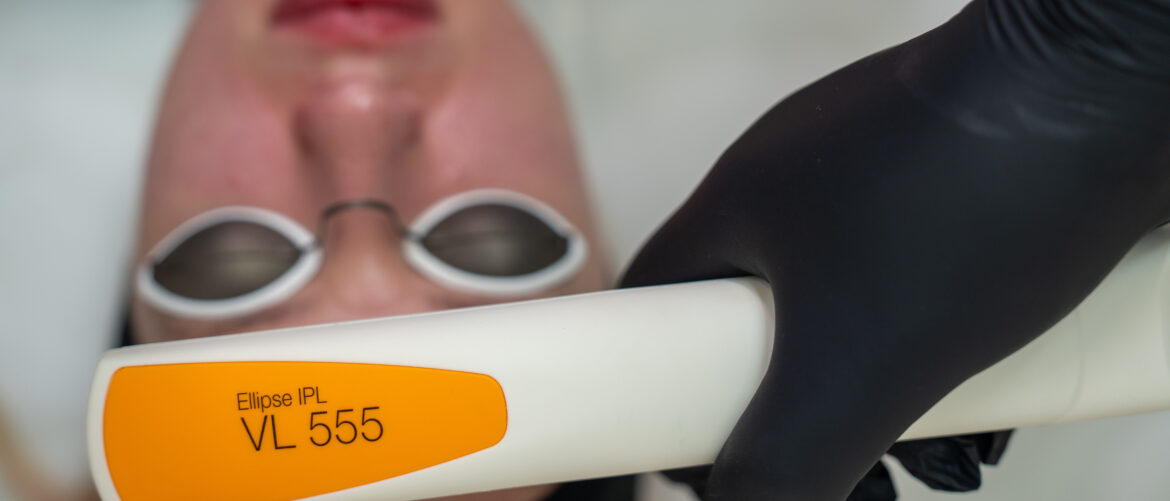#Rosacea is a chronic inflammatory skin disorder that primarily affects the central face, characterized by periods of flushing, persistent redness, visible blood vessels,(Telangiectasia), and in some cases, acne-like bumps. It often develops in adults over 30 and follows a relapsing-remitting course, meaning symptoms may flare up and subside over time. It is not contagious, but it can progressively worsen without treatment. In some individuals, rosacea may also involve the eyes (ocular rosacea) or lead to skin thickening, especially on the nose (rhinophyma).
Rosacea Triggers (Flare-Up Factors): Rosacea symptoms can worsen due to:
- Sun exposure
- Heat (hot weather, showers, spicy foods, hot drinks)
- Cold or wind
- Alcohol (especially red wine)
- Stress or strong emotions
- Strenuous exercise
- Skin products with alcohol, fragrance, or steroids
- Hormonal changes (e.g., menopause)
Etiology (Underlying Causes): Rosacea is believed to result from a combination of:
- Genetics – Runs in families; more common in fair-skinned people.
- Vascular dysfunction – Overreactive blood vessels cause redness and flushing.
- Immune system overactivity – Triggers inflammation in the skin.
- Demodex mites – Often found in larger numbers on rosacea-affected skin.
- Skin barrier issues – Increased sensitivity and reactivity.
Signs and Symptoms of Rosacea: Rosacea often begins subtly but can worsen over time without treatment. Key signs include:
Primary Symptoms:
- Persistent Facial Redness (Erythema): Central facial flushing or redness that comes and goes, often becoming permanent over time.
- Flushing and Blushing: Episodes of sudden redness, often in response to triggers like heat, alcohol, or stress.
- Visible Blood Vessels (Telangiectasia): Small, dilated blood vessels can appear on the cheeks and nose.
- Papules and Pustules: Acne-like bumps that may contain pus but without blackheads, unlike typical acne.
- Eye Irritation (Ocular Rosacea): Watery, bloodshot eyes, burning sensation, swollen eyelids, and even vision issues in severe cases.
- Burning or Stinging Sensations: Skin may feel sensitive, especially when applying skincare products or after sun exposure.
- Dry or Rough Skin Texture: Can cause scaling, especially during flare-ups.
- Thickened Skin (Phymatous Changes): Often on the nose (rhinophyma), causing a bulbous, enlarged appearance, typically in severe or untreated cases.
Types of Rosacea (Subtypes): Rosacea is classified into four main subtypes and a variant:
Erythematotelangiectatic Rosacea (ETR): Main Features: Persistent facial redness, flushing, and visible blood vessels.: Common sites: Cheeks, nose, and forehead. Skin Sensitivity: High — often accompanied by stinging and burning.
Papulopustular Rosacea (PPR):Main Features: Redness with acne-like breakouts (papules and pustules). Common Sites: Central face (especially the nose and cheeks). Often Mistaken For: Acne vulgaris — but lacks comedones (blackheads).
- Phymatous Rosacea: Main Features: Thickening of the skin and irregular surface texture.
- Common Sites: Nose (rhinophyma), chin, forehead, ears, eyelids.
- More Common In: Middle-aged men.
- May Require: Laser or surgical treatment for tissue reshaping.
- Ocular Rosacea: Main Features: Eye dryness, irritation, swollen eyelids, light sensitivity, and conjunctivitis.
- Can Precede Skin Symptoms: In many patients, ocular signs appear before facial rosacea.
- Variant: Neurogenic Rosacea: Rare subtype involving neurological symptoms like severe burning and stinging without prominent redness. Often resistant to standard therapies and may require a multidisciplinary approach.
At #Vancoderm_Academy and #VDCmed:
Students are trained to assess individual rosacea cases thoroughly and tailor cosmeceutical treatment plans to suit each client’s unique skin needs. Emphasis is placed on using gentle, effective protocols that minimize irritation, promote healing, and enhance skin resilience.
Azelaic Acid (10% or Less) for Rosacea Treatment
- Azelaic acid is a well-established ingredient in the treatment of rosacea, known for its anti-inflammatory, antibacterial, and skin-renewing properties. It helps reduce redness, swelling, and the formation of acne-like bumps often associated with rosacea.
- Tea Tree Oil (Melaleuca alternifolia): Known for its natural antimicrobial and acaricidal (mite-killing) properties, tea tree oil helps reduce Demodex populations. Formulations typically use low concentrations to minimize irritation.
-
Soothing Inflammation: Ingredients such as niacinamide, chamomile, and green tea extract help reduce redness.
-
Restoring the Skin Barrier: Components like ceramides and hyaluronic acid replenish moisture and repair the skin’s protective barrier to reduce sensitivity.
-
Controlling Irritants: Zinc and sulfur help manage acne-like breakouts associated with rosacea, while being gentle on delicate skin.
-
Protection Against Environmental Stressors: Antioxidants defend against UV damage and pollution, which can exacerbate rosacea symptoms.
Topical Medical Prescriptions for Cases Referred to a Physician:
- Azelaic Acid (15% gel): Reduces redness and inflammatory lesions by inhibiting certain enzymes. It has shown superior efficacy compared to metronidazole in some studies.
- Ivermectin (Soolantra): An anti-inflammatory agent that helps reduce inflammation and lesions.
- Metronidazole (Metrogel, Noritate): Commonly prescribed for its anti-inflammatory properties.
- Brimonidine (Mirvaso) and Oxymetazoline (Rhofade): Alpha-adrenergic agonists that constrict blood vessels, providing temporary relief from facial redness. However, overuse may lead to rebound redness.
Oral Medications
- Doxycycline (Oracea): A low-dose antibiotic that reduces inflammation.
- Minocycline (Emrosi): A newer treatment option approved by the FDA, showing significant improvement in reducing inflammation and redness.
- Isotretinoin: Reserved for severe cases unresponsive to other treatments due to its potent effects and potential side effects.Reuters
Laser and Light Therapies
- Nd:YAG 1064 nm and Narrowband Intense Pulsed Light (IPL): At #Vancoderm_Clinic (VDCmed), we use VL Narrowband IPL 555, Nordlys, and Candela devices to treat telangiectasia, and Nd:YAG 1064 nm laser for vascular conditions such as broken capillaries.
Surgical Interventions
- Rhinophyma Treatment: In cases of thickened skin on the nose, surgical options like laser ablation or surgical excision may be considered.
Skincare and Lifestyle Recommendations
- Gentle Skincare: Use non-irritating products free from alcohol and fragrances.
- Sun Protection: Apply a broad-spectrum sunscreen daily to prevent flare-ups.
- Avoid Triggers: Identify and steer clear of personal triggers such as spicy foods, alcohol, hot beverages, and extreme temperatures.
Eye Care: For ocular rosacea, maintain eyelid hygiene and consult an ophthalmologist for specialized treatment.

